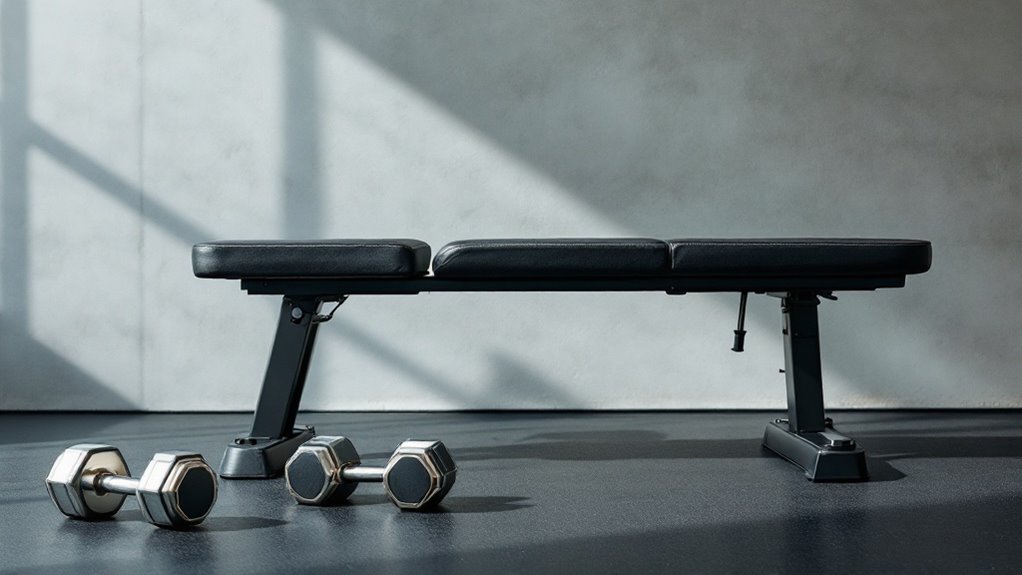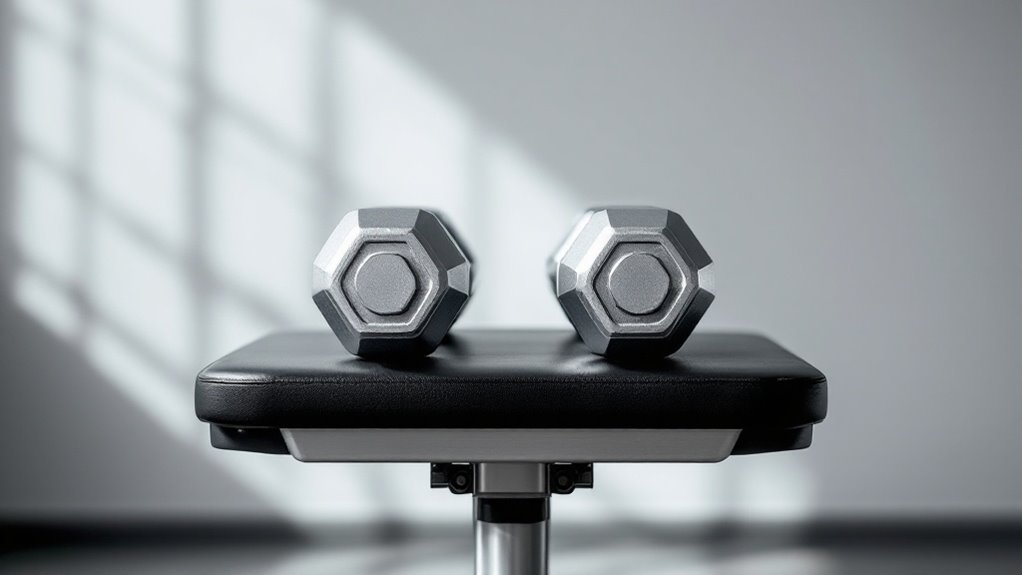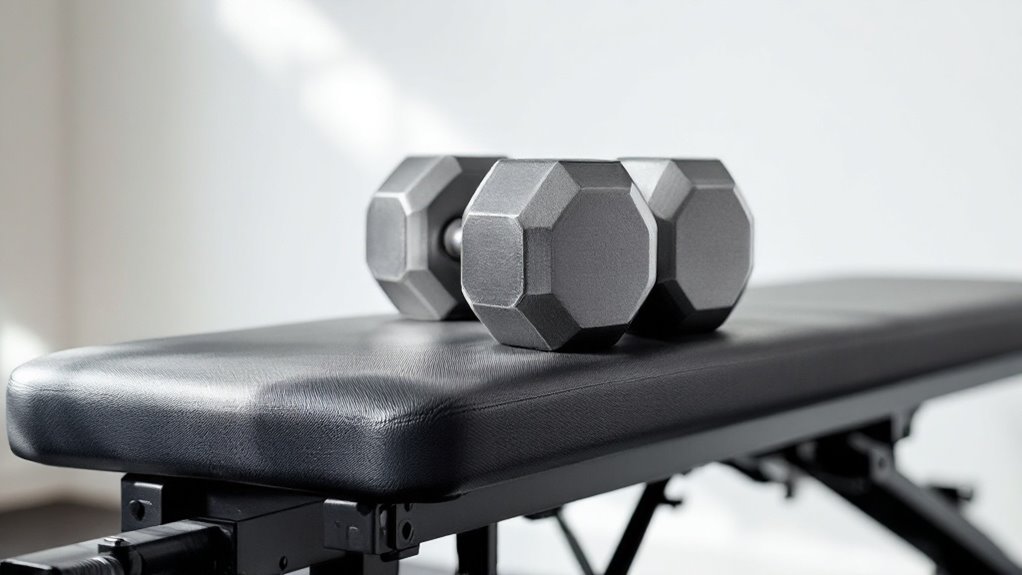Seated Dumbbell Shoulder Press

The seated dumbbell shoulder press targets anterior and lateral deltoids while involving stabilizing muscles like triceps and trapezius. This compound movement builds strength, improves shoulder mobility, and develops that coveted "capped" deltoid appearance. Using a bench with back support provides improved stability compared to standing variations, allowing lifters to focus on proper form and controlled movement patterns. Proper setup includes shoulder-width grip, neutral spine, and continuous core involvement. Mastering this foundational exercise reveals advanced shoulder development potential.
Key Takeaways
- Sit with back straight against a bench, feet flat on floor, and hold dumbbells at shoulder level with palms facing forward.
- Press dumbbells overhead until arms are fully extended, while maintaining contact between your back and the bench.
- Lower dumbbells slowly back to shoulder position in a controlled manner, keeping core engaged throughout the movement.
- Target anterior deltoids primarily while engaging lateral deltoids, triceps, and trapezius muscles as supporting muscle groups.
- Perform 3-5 sets with controlled form, focusing on vertical pressing motion and avoiding shoulder impingement through proper technique.
Essential Muscles and Structural Benefits

The seated dumbbell shoulder press stands as a cornerstone exercise in shoulder development, targeting multiple muscle groups while offering distinct structural advantages.
The movement primarily activates the anterior deltoids during the pressing motion, with lateral deltoids engaging as secondary movers. The triceps, trapezius, and serratus anterior work as essential stabilizers. Performing this exercise seated helps address muscular imbalances between arms. The upright bench position provides better stability and control for executing proper form. Similar to the barbell overhead press, this movement builds foundational pressing strength.
The anterior deltoids lead the press while lateral delts assist, supported by crucial stabilization from the triceps, traps, and serratus anterior.
Beyond muscle activation, this exercise delivers significant structural benefits. The independent arm movement improves bilateral coordination while strengthening stabilizing muscles.
The natural shoulder rotation pattern improves mobility and joint health, while the controlled motion builds stronger connective tissues. For aesthetic goals, consistent training develops the coveted "capped" shoulder appearance.
Step-by-Step Setup and Form Guide

Proper setup and form execution serve as critical foundations for maximizing the benefits of the seated dumbbell shoulder press while minimizing injury risk.
Begin by selecting a bench with proper back support and position feet firmly on the ground at shoulder width. Activate the core while maintaining neutral spine positioning. Soft contact against the backrest helps optimize scapular movement during the exercise. Grip width on dumbbells should mirror shoulder width for optimal pressing mechanics.
To initiate the movement, lift dumbbells to shoulder height, rotate palms forward, and retract shoulder blades against the backrest.
Press dumbbells overhead in a controlled motion, keeping them slightly in front of the head. Lower weights with sustained tension, maintaining proper breathing patterns throughout each repetition. The bench support allows you to focus more energy on the pressing movement compared to standing variations.
Mastering the Movement Pattern

Mastering the seated dumbbell shoulder press requires understanding key biomechanical principles that optimize both performance and safety. The movement pattern centers on vertical pressing through controlled thoracic extension while maintaining scapular stability. The exercise targets anterior deltoids as the primary movers during the overhead press.
Success depends on maintaining continuous bench contact while keeping the shoulder blades retracted throughout the press. This creates a stable foundation for the deltoids and triceps to work efficiently. Most athletes perform 3-5 sets for optimal muscle development.
Proper execution minimizes shoulder impingement risk by avoiding excessive shrugging and anterior humeral glide. Athletes should focus on smooth, controlled movements with proper grip positioning and consistent scapular pro-retraction during the pressing phase to reduce accessory muscle strain. Regular practice of external rotation exercises helps maintain rotator cuff strength and stability during pressing movements.
Training Adaptations and Exercise Variations

Successful shoulder press training demands strategic exercise programming to optimize muscular adaptations and movement variations.
Athletes can target specific deltoid regions through controlled adjustments in torso position and range of motion. Front delts respond well to rigid posture maintenance, while lateral delts benefit from reduced torso extension. Core engagement helps maintain stability throughout pressing movements. Movement control requires a 30-degree bench angle for optimal chest-to-shoulder engagement during pressing variations. Following a periodized program helps prevent plateaus and ensures consistent strength gains.
Progressive overload remains essential through weight increases, volume manipulation, and intensity techniques like cluster sets and drop sets.
Progressive training demands strategic load increases and advanced methods like clusters and drops to stimulate continuous strength gains.
Training adaptations are improved by varying tempo – from explosive concentric phases to slow, controlled eccentrics with isometric holds.
These modifications, combined with periodic strength testing, create a thorough approach to shoulder development and functional pressing power.
Frequently Asked Questions
Can I Substitute Barbells for Dumbbells if My Gym Lacks Proper Equipment?
Barbell substitution is a viable alternative that can effectively target shoulder muscles. The barbell allows heavier loads and improved pressing efficiency, potentially leading to greater strength gains.
While dumbbells offer superior isolation and stabilizer involvement, proper barbell form can still deliver results. Key adjustments include maintaining strict vertical bar path and focusing on controlled movement to prevent overextension during lockout.
How Long Should I Rest Between Sets of Shoulder Presses?
Like a well-oiled machine, rest periods are essential for peak performance.
For hypertrophy goals under 30 reps, athletes should rest 1-2 minutes between sets to maintain intensity while allowing adequate recovery. This timeframe strikes the perfect balance between sustaining muscle tension and preventing fatigue-induced form breakdown.
Shorter rests may compromise strength, while longer breaks could reduce the workout's metabolic benefits.
What Weight Should Beginners Start With for Shoulder Presses?
Most beginners should start with 5-10 pound dumbbells per arm to master proper form and build foundational strength.
Women typically begin with 5-8 pounds, while men often start with 8-10 pounds.
Testing the weight with 10-15 controlled repetitions guarantees safety – if form breaks down, the weight is too heavy.
Gradual increases of 2-5 pounds can occur once proper technique is mastered.
Should I Train Shoulders Before or After Chest Day?
Training shoulders after chest has emerged as the preferred sequence for most athletes.
Since shoulders assist in chest movements, pre-fatiguing them before chest exercises can limit performance.
However, advanced lifters may benefit from alternating the order between workouts.
For ideal results, spacing chest and shoulder training 48-72 hours apart allows adequate recovery while maintaining consistent progress in both muscle groups.
Is It Normal to Feel Shoulder Clicking During Dumbbell Presses?
Shoulder clicking during pressing movements is relatively common and can be normal if there's no associated pain.
It often occurs due to tendons sliding over bone or natural joint mechanics.
However, persistent clicking accompanied by discomfort may indicate underlying issues like rotator cuff strain or shoulder impingement.
Regular mobility work, proper warm-ups, and maintaining good form can help minimize clicking sensations during exercises.
Final Thoughts
The seated dumbbell shoulder press stands as a cornerstone exercise for developing impressive deltoids and upper body strength. Research suggests that seated variations provide improved stability and control compared to standing presses, allowing lifters to focus purely on shoulder involvement. Through proper form, progressive overload, and strategic variations, this movement can transform not only shoulder aesthetics but also functional pressing power for both novice and advanced athletes.


